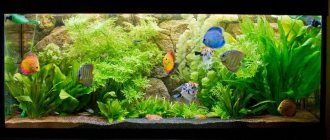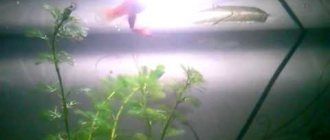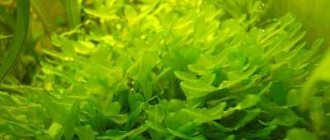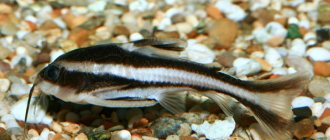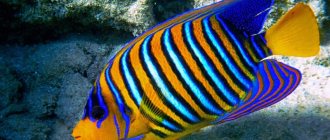The angelfish can be called the most aspiring fish in the home aquarium. Her body is arrow-like due to the special shape of her fins. You can often hear the opinion that the angelfish is a fairly peaceful fish that can get along with different neighbors. But do not forget that this is a cichlid, and the habits of a predator remain even in the body of the smallest representative of this genus.
Description and habitat
Angelfish are fish of the Cichlid family. The “Freshwater Angel” is distinguished by a disc-shaped, high, laterally compressed body shape. Height up to 25 cm, length up to 15 cm. The caudal and pectoral fins are pointed at the end, the ventral fins look like threads, the dorsal and anal fins are elongated because of this the fish looks like a crescent.
The natural color is olive-gray, with black stripes across and a silver tint. The back is darker than the belly. Breeders selected individuals with different color options: green, gold, white, olive, marbled, red, blue, multi-colored. The scales of the fish are small. The difference between male and female is weakly expressed.
The homeland of the angelfish is the Amazon, tributaries of Peru, Brazil, and Ecuador. They swim in the basins of the Orinoco and Essequibo rivers. They love bodies of water with slow currents and dense reed vegetation. It has been bred in aquariums since the last century.
How to distinguish a female from a male
Angelfish become sexually mature at the age of about a year. At this time they begin to break into pairs. It is impossible to influence this process. A pair of angelfish tries to stay together everywhere. This is one of the signs that angelfish are ready to reproduce.
To determine the sex of an angelfish, you can compare two individuals from a pair. The male will have a noticeable tubercle on his forehead (not typical for all species), and forked fins. Females are somewhat slimmer and smaller. The back line and dorsal fin of the male are at an angle to each other, and the abdomen and anal fin are in a straight line. And for the female it’s the opposite.
Varieties
There are three main types of angelfish:
- Common - the body is like a disk, the fins are like a sail.
- Leopolda is a rare species, with black stripes on the body and one extending onto the dorsal fin.
- Altum - distinguished by its large size (height up to 0.5 in nature), a depression between the forehead and mouth. It has four transverse black stripes and red dots on the fins.
Many varieties have been bred from them.
| Name | Peculiarities |
| Diamond | Silver in color, some with dark stripes, transparent fins. The scales sparkle beautifully in the light. |
| Bicolor | Black and silver body shade, with one stripe between them. |
| Platinum | Luminous, light silver. |
| Blue Angel | Translucent blue fins without stripes are more valuable. |
| Golden | Half of the body is silver, the rest is bright yellow. |
| Koi (red-headed) | Red, black, orange spots on a white background. |
| Red Devil | Bright red spots. |
| Marble | Silvery, black spots and stripes. |
| Zebra | Black stripes on a light background. |
| Black velvet | Completely black in color, sometimes with gray spots on the belly and fins. |
| Pink glowing | It turned out thanks to genetic engineering, but is not widely distributed. |
| Dantum Albino | White, fins look like a sail. Afraid of the light. The Peruvian form, white, large in size, is distinguished by red eyes and poor vision, photophobia. |
| Veiled | Translucent, curved elongated fins of different colors. It floats on the surface and almost never sinks to the bottom. |
| Pearl | The iridescent, light silver color is due to a recessive gene. |
| Paraiba (phantom) | Blue in daylight, with a luminous sheen and a green spot on the back, without stripes. The fins are black and gray. |
| Jacobin | Elongated body, wide fins. |
| Birch | Light background and vertical dark stripes. |
| Lace (black, zebra) | Light specks look like lace. |
| Smoky | The back half is brown or gray. |
| Chocolate | Silver head and dark body. |
| Rio Nanay (Peruvian red-spotted) | Contrasting vertical stripes, red-brown spots, olive and turquoise gill covers. Found in the Rio Nanay River in Peru. |
| Golden red-cheeked | The body is white, with a red “blush” on the sides of the head. |
| Redback (Manakapuru) | The back is blue, iridescent, the anal fin is turquoise, the pectoral fin is white-blue, the back is red. |
History of domestication
Ferdinand Schulz described the angelfish in 1823 and gave it the name Zeus scalaris. The famous Austrian zoologist named it in 1840 - Pterophyllum, which means “winged leaf” from Latin. Georges Cuvier described and named the fish Platax sciaris in 1931.
It was possible to bring fish to Germany in 1911; before they died. In 1914, they were propagated artificially for the first time; details were not disclosed until 1920, then aquarium hobbyists began breeding angelfish everywhere. It came to the USA in 1930. In the second half of the 20th century, breeders developed many breeds of this species.
Photo gallery of angelfish:
Maintenance and care in the aquarium
Keeping and caring for angelfish requires special attention. Place the artificial pond in a quiet place, covering it with a lid. Individuals are shy, afraid of unnecessary noise and shadows. They are kept in groups, in a free aquarium, at least 150 liters per couple. The water must be clean, slightly acidic, temperature + 24…+26 °C. Filtration is moderate, water changes are 20% every week.
The food is suitable: daphnia, bloodworms, coretra, good quality dry flakes, frozen minced seafood. It is inconvenient for the fish to pick up food from the bottom, so a small feeder is installed inside the aquarium.
You should not overfeed, otherwise the angelfish will become lethargic and inactive.
Include spirulina and animal protein in your diet. Give food 2-3 times a day.
The light is muted, without a sharp change of day and night. Plants create a natural habitat, shade bright light, and shy fish feel protected. They use nymphea or water lily, echinodorus, vallisneria, rootless wolfia, lemongrass, and water ferns. Place coarse sand and fine gravel on the bottom. Decorate with rocks, driftwood, without sharp objects.
The fry require food 8-14 days after emergence. Usually these are brine shrimp. The lifespan of an angelfish is 3 years, but with proper care it can reach 10 years.
Feeding the fish
Angelfish are not picky eaters. They happily eat both frozen food (bloodworms, brine shrimp, koretra, daphnia) and dry food (flakes and granules).
Angelfish are unpretentious in their diet. Almost any live food is perfect for them: bloodworms, daphnia, tadpoles and others. But when feeding fish, you need to be sure that the food they receive is of high quality and does not contain harmful microorganisms and pathogens of infectious diseases.
For this reason, it is better to feed the angelfish with frozen food that has been preheated to room temperature. In addition, it is allowed to use the following as food for this type of aquarium fish:
- small ground beef or chopped seafood;
- specialized dry food in flakes or granules;
- plant food (wolfia, riccia, duckweed).
If you prepare food for angelfish yourself, then you should definitely add a little vegetable food to the protein food. This will ensure good digestion for the fish and provide them with all the necessary microelements.
You should pour food into the aquarium 2-3 times a day in small portions. The fish should eat the entire portion of food in 2-3 minutes. Otherwise, there is a risk of overfeeding, which can negatively affect the health of the inhabitants and their life expectancy. Once a week, a fasting day without animal food is recommended.
This is an omnivorous fish that will suit one of the following types of food:
- Live - tubifex, bloodworm, brine shrimp, coretra.
- Frozen.
- Artificial - flakes.
Both males and females are terribly gluttonous, so they should not be overfed. Bloodworms are given very carefully, but in general, it is better to avoid it altogether. If you overfeed a fish, its tummy will swell. It is better to use high-quality artificial feed.
Sometimes angelfish in an aquarium can tear off plants. For example, they nibble eleocharis and moss from driftwood. If this behavior is noticed, you can add food with spirulina to their diet.
Difficulties and features
For inexperienced aquarists, keeping angelfish at home is difficult; it requires a large artificial reservoir, with a minimum depth of 45 cm and a length of 90 cm. Moreover, its width can be small; in nature, thanks to its narrow bodies, this species lives even in tight crevices. It is better to keep individuals in groups of 4-8 individuals; this is a schooling type of underwater inhabitants.
It is advisable to divide the aquarium into zones: place large-leaved plants along the walls, creeping on the surface, decorate the corners with caves so that the fish hide there. At the same time, leave room for swimming.
Pairs usually occupy their favorite places in the tank, and a single individual most often dies. This must be taken into account when populating an artificial reservoir.
Angelfish do not tolerate sudden temperature fluctuations, unexpected loud sounds and constant noise. This can lead to stress, loss of brightness of body coloring and even death of fish. All these factors must be taken into account when choosing a place for an artificial pond in the house.
Compatibility of angelfish Altum Peruvian
Angelfish Altum Orinoco - does not seem to be a morph
By nature, angelfish are peaceful schooling fish, however, during the breeding season they become very aggressive. It easily gets along with peace-loving fish species: small tetras (neons, amanda tetras, etc.), they look good with swordtails. They go well with corydoras and small loricariid catfish.
Angelfish are incompatible with: guppies, goldfish. Although discus fish are also “relatives,” in our opinion, they are not the best neighbors for angelfish. Discus love warm water 30+, they are capricious, and grow into large fish. In general, we are in favor of keeping discus fish separately - in a species aquarium.
Diseases and prevention
If improperly cared for, fish diseases can occur. If this happens, sick individuals are removed, the aquarium water is disinfected and changed.
| Disease | Manifestation | Treatment |
| Helminthiasis | She is exhausted and doesn't eat well. | Give anthelmintic drugs to all inhabitants of the reservoir. |
| Infection with microspores | Gray spots on the body. | Isolate. There is no treatment. Carry out disinfection. Add methylene blue to the water. |
| Tuberculosis | Weight loss, bulging eyes, poor appetite. | Seed and disinfect the water. |
| Fin rot | The color of the fins changes. | Antifungal drugs, change the water. |
| Vibriosis | Bloating, loss of appetite, red spots due to hemorrhages. | Quarantine, determine water quality, use antibiotics. |
| Pseudomonas aeruginosa | There are ulcers on the side of the body, poor functioning of the liver, kidneys, internal hemorrhages in the oral cavity. | Isolate patients in a separate container and introduce medications into the general aquarium. Use antibiotics prescribed by a specialist. |
| Ammonia poisoning | The fish swims with its belly up, trying to jump out, its gills are dark, its breathing is rapid. | Stop feeding, change water by 1/3, clean aquarium equipment, add ammonia neutralizing agents. |
| Chlorine poisoning | Redness of fins and body. Unusual behavior, the fish tries to jump out, breathing is difficult. | Replant in settled water. |
| Glucose | White bumps, dots on the body, the fish does not move, lies on its side. | There is no treatment, the fish are eliminated and the water is changed. |
| Hexamitosis | Erosion of the scalp, sides, thin, white excrement. | Special medications are prescribed by the doctor. |
| Iridovirus infection | The abdomen is greatly swollen, the fish is weak and does not eat anything. | Cannot be treated. |
| Gyrodactylosis | Accompanied by itching, the fish rubs against the walls of the aquarium, stones, bottom, body in white mucus. | Special medicines are added to the water: malachite green, formamed, copper sulfate. |
| Ichthyosporidiosis. | The color darkens, the scales rise, the fish becomes bug-eyed and does not eat. | Antifungal drugs. |
To prevent diseases, it is necessary to follow the rules of care: do not overcool the water, change 20-30% every week, avoid temperature changes, keep the filters clean, feed only high-quality food, first quarantine new fish, use special tests to determine the amount of ammonia .
Aquarium propagation
Preparation for spawning consists of setting the temperature to +27...+32 °C, regular fluid changes, filtration, and aeration. Fish require enough space, at least 100 liters for a pair, shelter, and up to 10 hours of daylight.
They reach sexual maturity at 6-12 months and look for a mate on their own. After its formation, the male and female stay together, guard their chosen place, drive away neighbors, and the female cleans it. Its intention to spawn is determined by the increase in the size of its abdomen.
The female lays eggs on large leaves and pieces of driftwood. After this, the male fertilizes her, showering her with milk. In this case, 700-800 eggs are formed. Then the couple takes care of them, fans them, and eats the unfertilized ones (they turn white). The larvae hatch after three days, but still remain on the surface and feed on the contents of the yolk sac. After 7-12 days the fry are already swimming. They are fed with ciliates, cyclops, small bloodworms, and brine shrimp.
Often, owners select eggs and raise future fish in an incubator.
Read more in the article about breeding angelfish.
Reviews of angelfish
A beautiful, strong, curious fish. She quickly eats all the food, although she is almost motionless. Slow armadillo. After changing the water, it sits behind the plant for 5 minutes. She laid eggs in my aquarium with a marbled angelfish - it was amazing!
The angelfish was brought exactly as in the picture, large (in accordance with the M size), healthy, with a good appetite, they calmly joined a flock of adult koi angelfish. More precisely, the first evening the old-timers tried to drive them away, but in the morning everyone swam together in unison, apparently they agreed. Thanks to the store for the conscientious selection of goods!
We have been keeping these unpretentious fish for many years. They get along with calm fish of the same size. They grow quickly from small, timid fish into large and beautiful schooling beauties. They often stay together, and pairs usually form for life. We keep 6 fish in 140 liters, several catfish.

